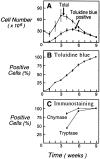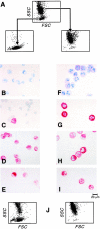T helper cell type 2 cytokine-mediated comitogenic responses and CCR3 expression during differentiation of human mast cells in vitro
- PMID: 10432289
- PMCID: PMC2195573
- DOI: 10.1084/jem.190.2.267
T helper cell type 2 cytokine-mediated comitogenic responses and CCR3 expression during differentiation of human mast cells in vitro
Abstract
Mast cells (MCs) arise in situ from circulating stem cell factor (SCF)-dependent committed progenitors (PrMCs) and accumulate at sites of allergic mucosal inflammation. We hypothesized that human (h)PrMCs and their mature counterparts might share overlapping patterns of chemokine and cytokine receptor utilization with eosinophils, basophils, and T helper type 2 (Th2) lymphocytes for their homing and allergy-associated hyperplasia. We have characterized committed hPrMCs and fully mature hMCs derived in vitro from cord blood for their functional responses to chemokine and cytokine agonists germane to allergic inflammation and for their maturation-related expression of the corresponding receptors. After 4 wk of culture in the presence of recombinant stem cell factor (SCF), interleukin (IL)-6, and IL-10, the cells were characterized as hPrMCs based upon their uniform surface expression of c-kit and CD13, low-level expression of FcinRIalpha, absence of CD14 and CD16 expression, and immunoreactivity for MC chymase in >80%, and about half were immunoreactive for tryptase and metachromatic with toluidine blue. By week 9, the cells had matured into hMCs, identified by higher levels of c-kit, continued expression of CD13 and low-level FcinRIalpha, uniform toluidine blue metachromasia, and uniform immunoreactivity for both tryptase and chymase. The 4-wk-old hPrMCs expressed four chemokine receptors (CXCR2, CCR3, CXCR4, and CCR5). Each receptor mediated transient rapid calcium fluxes in response to its respective ligand. Both recombinant human eotaxin and stromal cell-derived factor 1alpha elicited chemotaxis of hPrMCs. Only CCR3 was retained on the mature 9-wk-old hMCs from among these chemokine receptors, and hMCs responded to eotaxin with a sustained calcium flux but without chemotaxis. The Th2 cytokines IL-3, IL-5, IL-6, IL-9, and granulocyte/macrophage colony-stimulating factor each augmented the SCF-dependent proliferation of hPrMCs and hMCs. In contrast, the prototypical Th1 cytokine, interferon gamma, suppressed SCF-driven proliferation of both hPrMCs and hMCs. Thus, throughout their development in vitro, hMCs obey SCF-dependent, cytokine-driven mitogenic responses that reflect a Th2-type polarization characteristic of allergy and asthma. Furthermore, committed hPrMCs have a unique profile of chemokine receptor expression from among reported hematopoietic cells, including CCR3, which is shared with the other cells central to allergic inflammation (eosinophils, basophils, and Th2 lymphocytes).
Figures









Similar articles
-
T helper cell type 2 cytokines coordinately regulate immunoglobulin E-dependent cysteinyl leukotriene production by human cord blood-derived mast cells: profound induction of leukotriene C(4) synthase expression by interleukin 4.J Exp Med. 2001 Jan 1;193(1):123-33. doi: 10.1084/jem.193.1.123. J Exp Med. 2001. PMID: 11136826 Free PMC article.
-
The CCR3 receptor is involved in eosinophil differentiation and is up-regulated by Th2 cytokines in CD34+ progenitor cells.J Immunol. 2003 Jan 1;170(1):537-47. doi: 10.4049/jimmunol.170.1.537. J Immunol. 2003. PMID: 12496441
-
High-resolution tracking of cell division demonstrates differential effects of TH1 and TH2 cytokines on SCF-dependent human mast cell production in vitro: correlation with apoptosis and Kit expression.Blood. 2005 Jan 15;105(2):592-9. doi: 10.1182/blood-2004-07-2838. Epub 2004 Sep 14. Blood. 2005. PMID: 15367434
-
The role of human mast cell-derived cytokines in eosinophil biology.J Interferon Cytokine Res. 2004 May;24(5):271-81. doi: 10.1089/107999004323065057. J Interferon Cytokine Res. 2004. PMID: 15153310 Review.
-
Role of human FcepsilonRI+ cells in HIV-1 infection.Immunol Rev. 2001 Feb;179:128-38. doi: 10.1034/j.1600-065x.2001.790113.x. Immunol Rev. 2001. PMID: 11292016 Review.
Cited by
-
Leukocyte migration and graft-versus-host disease.Blood. 2005 Jun 1;105(11):4191-9. doi: 10.1182/blood-2004-12-4726. Epub 2005 Feb 8. Blood. 2005. PMID: 15701715 Free PMC article. Review.
-
Interferon-γ regulates growth and controls Fcγ receptor expression and activation in human intestinal mast cells.BMC Immunol. 2014 Jul 5;15:27. doi: 10.1186/1471-2172-15-27. BMC Immunol. 2014. PMID: 24996251 Free PMC article.
-
Eotaxin-3 and a uniquely conserved gene-expression profile in eosinophilic esophagitis.J Clin Invest. 2006 Feb;116(2):536-47. doi: 10.1172/JCI26679. J Clin Invest. 2006. PMID: 16453027 Free PMC article.
-
Human mast cells express multiple EP receptors for prostaglandin E2 that differentially modulate activation responses.Blood. 2006 Apr 15;107(8):3243-50. doi: 10.1182/blood-2005-07-2772. Epub 2005 Dec 15. Blood. 2006. PMID: 16357326 Free PMC article.
-
CCR3 is essential for skin eosinophilia and airway hyperresponsiveness in a murine model of allergic skin inflammation.J Clin Invest. 2002 Mar;109(5):621-8. doi: 10.1172/JCI14097. J Clin Invest. 2002. PMID: 11877470 Free PMC article.
References
-
- Donaldson L.E., Schmitt E., Huntley J.F., Newlands G.F., Grencis R.K. A critical role for stem cell factor and c-kit in host protective immunity to an intestinal hel–minth. Int. Immunol. 1996;8:559–567. - PubMed
-
- Echtenacher B., Mannel D.N., Hultner L. Critical protective role of mast cells in a model of acute septic peritonitis. Nature. 1996;381:75–79. - PubMed
-
- O'Sullivan S., Dahlen B., Dahlen S.E., Kumlin M. Increased urinary excretion of the prostaglandin D2 metabolite 9α, 11 β-prostaglandin F2 after aspirin challenge supports mast cell activation in aspirin-induced airway obstruction. J. Allergy Clin. Immunol. 1996;98:421–432. - PubMed
-
- Castells M., Schwartz L.B. Tryptase levels in nasal lavage fluid as an indicator of the immediate allergic response. J. Allergy Clin. Immunol. 1988;82:348–355. - PubMed
Publication types
MeSH terms
Substances
Grants and funding
LinkOut - more resources
Full Text Sources
Other Literature Sources
Research Materials
Miscellaneous

